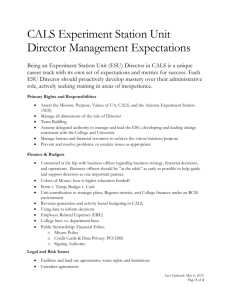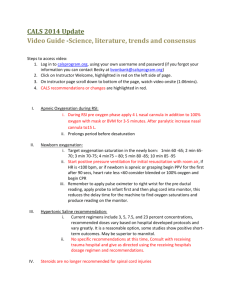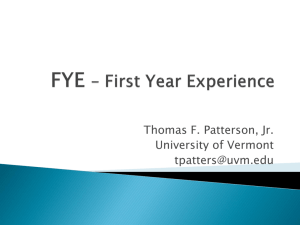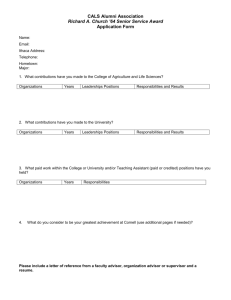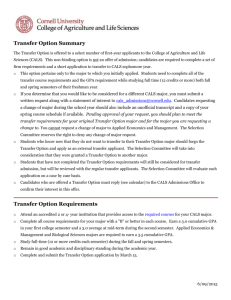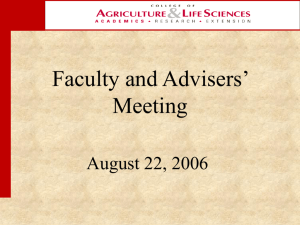CALS Career and Academic Services 2021 STRATEGIC PLAN (Revised 12/2/14)
advertisement
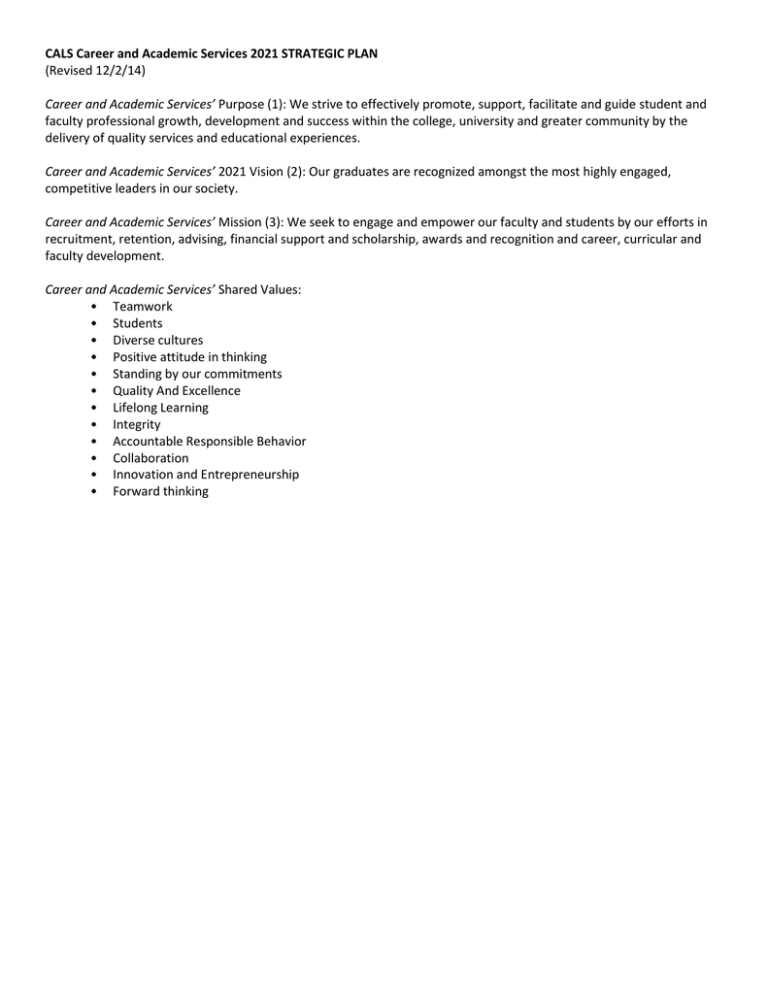
CALS Career and Academic Services 2021 STRATEGIC PLAN (Revised 12/2/14) Career and Academic Services’ Purpose (1): We strive to effectively promote, support, facilitate and guide student and faculty professional growth, development and success within the college, university and greater community by the delivery of quality services and educational experiences. Career and Academic Services’ 2021 Vision (2): Our graduates are recognized amongst the most highly engaged, competitive leaders in our society. Career and Academic Services’ Mission (3): We seek to engage and empower our faculty and students by our efforts in recruitment, retention, advising, financial support and scholarship, awards and recognition and career, curricular and faculty development. Career and Academic Services’ Shared Values: • Teamwork • Students • Diverse cultures • Positive attitude in thinking • Standing by our commitments • Quality And Excellence • Lifelong Learning • Integrity • Accountable Responsible Behavior • Collaboration • Innovation and Entrepreneurship • Forward thinking STRATEGIC GOAL ONE: ENHANCE STUDENT LEARNING OPPORTUNITIES ABOR Education Excellence & Access Workforce & Community Productivity Alignment with Strategic Goals U of A Engaging Innovative Partnering Synergy CALS Produce employable graduates, who can do jobs that do not yet exist and create new jobs A. Current situation and gap between current situation and desired situation CALS does an excellent job with the current academic programs. However, the following areas are in the early stages of advancing • Our global and distance learning options • Utilizing technologies and developing new technologies that can increase learning opportunities for students • Providing stronger “hands-on” learning where students participate in “real world” or virtual practical experiences • Adopting learner-centered approaches that encourage students to take responsibility for their own learning Gaps exist between current practices in each of these areas and what is possible. Further, the UA strategic plan includes increasing online learners by 10,000 in the coming decade. To remain internally and externally competitive we need to have and execute a plan that will advance each of these areas in CALS, enhancing the undergraduate and graduate experience. B. Strategies to achieve goal. i. Develop innovative curricula ii. Utilize the skills and knowledge of the CALS curriculum committee iii. Bring industry and the community virtually into the classroom to increase their participation in student learning iv. Explore and develop structures for students to participate in Global learning (study abroad, online and exchange opportunities) v. Create an engaging student environment within CALS where student participation in clubs, leadership and experiential learning activities is expected as the norm vi. Acknowledge and provide high-ability (honors; honors-eligible) students the opportunity to engage and interact with each other C. Actions and Time Period • Provide increased opportunities for hands on and learner-centered experiences (100% engagement) • Provide faculty workshops to facilitate ideas for in class hands-on experiences such as incorporation of global activities • Engage faculty, industry, and community partners through the use of video and podcasts to bring unique environments and experiences into the classroom and to advise on curriculum to meet workforce needs • Develop certificate programs and merit badges • Charge curriculum and assessment committee with reviewing curricula within CALS to improve efficiencies • Establish webpage for intra-college curriculum and assessment committee • Assist with study abroad program development • Create a Agri-life Council involving CALS student clubs and organizations • Encourage formation of a graduate student organization or council and facilitate TA training D. Inputs needed to achieve the goal • Faculty/Appointed Personnel with expertise in various areas to help with workshops/curriculum • Acknowledgement of faculty/appointed personnel who participate as club advisors, experiential learning, etc. • Industrial contacts • Creation of certificates and badges • Formation of an advisory board • Maintain website E. Objective metrics that will be used to track progress towards attaining goal • Measuring the number of: student internships, revised curricula, new courses, industry contacts and relationships, faculty workshops and attendance, study abroad certificates and merit badges • Number of honors programs and participation STRATEGIC GOAL TWO: IMPROVE LEARNING AND CAREER DEVELOPMENT INFRASTRUCTURE ABOR Education Excellence & Access Workforce & Community Productivity Alignment with Strategic Goals U of A Engaging Innovative Partnering Synergy CALS Produce employable graduates, who can do jobs that do not yet exist and create new jobs A. Current situation and gap between current situation and desired situation Academic Programs is currently housed in 2 separate offices with limited space for students. Because of this space limitation, we cannot increase and promote student learning and career development effectively. Through the development of a CALS student center with some study areas and technologies, we could be much more effective in message delivery. Ideally, the CALS academic advisors and career center will be adjacent for increased visibility and accessibility. Students would be able to identify with a “home” in CALS by having a common place to visit. B. Strategies to achieve goal i. Provide space for students with some technology ii. Modernize classrooms (to make more interactive) iii. Explore opportunities for developing satellite education centers vii. Create a structure to support Leadership, Communication and Education to prepare students for careers C. Actions and Time Period (Fiscal Years) • Work with E.C. and Dean to identify and renovate space in Forbes • Promote a dynamic friendly receptive learning environment • Give an annual open house to meet and engage students in CALS • College-wide upgrade of classrooms and laboratories • Increase infrastructure for virtual classrooms and labs • Conduct surveys electronically rather than on paper D. Inputs needed to achieve the goal (not limited to financial) • Money for renovation of space and equipment • Staff interaction E. Objective metrics that will be used to track progress towards attaining goal A. Number of students using the student center B. Number of students engaging in career development in CALS and UA Career Services C. Use of modernized classrooms Notes Future strategy to improve learning is to use student center for some limited tutoring and student workshops STRATEGIC GOAL THREE: DEVELOP FINANCIAL SUPPORT FOR CAREER AND ACADEMIC SERVICES ABOR Productivity Alignment with Strategic Goals U of A Engaging Innovative Partnering Synergy CALS Be effective, efficient, responsive, flexible and financially sustainable A. Current situation and gap between current situation and desired situation CALS has many donors who have given generously to our scholarship fund. These funds benefit hundreds of students each year; however they do not give flexibility of use in other programs. While maintaining our strong scholarship base, academic programs sees the need for financial support of other CAREER AND ACADEMIC SERVICES. Examples of this include funding and maintaining a student center (Goal 2), funding for materials for recruitment, funding for programming to ensure retention and academic success of our students. B. Strategies to achieve goal. i. Use the new logo and develop branding for the CALS undergraduate and graduate academic programs ii. Website development for improved use interface and recruitment iii. Working with Alumni i. Explore and capitalize on educational grant opportunities ii. Develop a marketing plan and strategy iii. Identify and engage possible appropriate donors C. Actions and Time Period (Fiscal Years) • Update all items using new logo • Fundraising link • Make website more user friendly and informational • Develop an app - for CALS Academic Programs • Engage CALS alumni in the classroom • Fundraising with CALS and UA alumni association; rethink post-marketing plan D. Inputs needed to achieve the goal (not limited to financial) • Technology and creative development • Cooperation with the Alumni and Development office • Alumni input E. Objective metrics that will be used to track progress towards attaining goal A. Amount of dollars donated B. Amount of dollars obtained through grants or other sources STRATEGIC GOAL FOUR: ENHANCE CAREER DEVELOPMENT ABOR Education Excellence & Access Workforce & Community Productivity Alignment with Strategic Goals U of A Engaging Innovative Partnering Synergy CALS Produce employable graduates, who can do jobs that do not yet exist and create new jobs Be a leading economic development engine for Arizona Be the most sought-after place to be a part of A. Current situation and gap between current situation and desired situation Career and Academic Services has a strong working relationship with UA Career Services Center. However, due to the wide range of unique majors in our college, there needs to be a greater effort put forward in engaging our students in career exploration and experience. This includes working with departments to develop more structured programs for internships, leadership development and other programs that will make our students more competitive in the industry. B. Strategies to achieve goal i. Increase knowledge of opportunities to students for post-graduate employment ii. Work with the units and industry to increase numbers of available internships and to create industrial and service 100% engagement opportunities for students iii. Increase opportunities for developing leadership, communication and problem solving skills iv. Work closely with the University Career Services Center C. Actions and Time Period (Fiscal Years) • Increase industry contacts • Form an industry and alumni advisory council to support the career center • Promote internships and experiential learning opportunities • Increase student connection with UA career services • Provide and develop opportunities for students to meet employers • Coordinate with Career fair • Provide a student space for the career center • Offer a curricula targeted at developing career skills defined by CALS student goals • Define competencies for the career skills and implement incorporation of the competencies into student training • Work with UA Career Center to update career brochures • Get all students to use Linkedin; use Linkedin to engage students through class assignments, and continue contacts through CALS alumni message boards D. Inputs needed to achieve the goal (not limited to financial) • People • Contacts with employers E. Objective metrics that will be used to track progress towards attaining goal A. Through the use of graduating and post-graduation surveys, obtain employment information from graduates B. Employer feedback regarding students they hired (preparedness, leadership ability, etc.) C. Number of internships participated in by our students D. Number of students using career services STRATEGIC GOAL FIVE: EXPAND INNOVATIVE EDUCATIONAL PROGRAMS ABOR Education Excellence & Access Workforce & Community Productivity Alignment with Strategic Goals U of A Engaging Innovative Partnering Synergy CALS Be a leading economic development engine for Arizona Produce employable graduates, who can do jobs that do not yet exist and create new jobs Be the most sought-after place to be a part of A. Current situation and gap between current situation and desired situation CALS has excellent relationships with many Arizona Community Colleges, especially in Yuma at Arizona Western College and in Casa Grande at Central Arizona College. We have established many 2 + 2 programs and some, as in Yuma, are completed mostly via distance by online course offerings. However, we have extensive expansion capabilities with regard to distance education programs and other innovative educational experiences. B. Strategies to achieve goal. i. Increase collaboration with Global and Student Affairs ii. Explore, develop and enhance relationships with community colleges iii. Increase distance education degrees and programs iv. Explore and develop new structures for degrees while maintain quality of degree programs v. Apply to the Office of Instruction and Assessment for grant monies available for building online and hybrid courses C. Actions and Time Period (Fiscal Years) • Develop certificate programs • Increase online courses for seamless transfer to the U of A • Increase opportunities for transfer student participation in CALS • Improve structure for multi-venue delivery • Faculty workshops on online learning course development and social media • Create branded templates for online courses • Develop and implement 2 + 2 and 3 + 1 strategy for course offerings for distance learners (applied degrees) • Create a model and infrastructure for co-convening of classes locally, nationally and globally • Create fully online degrees • Create programs to be offered in a bi-lingual format *See Appendix A: CALS-CAS Distance and Global Initiatives: A Five-Year Plan for more detailed information D. Inputs needed to achieve the goal (not limited to financial) • A person partially or wholly dedicated to this effort • Faculty willing to learn and participate in distance programs • Financial assistance to help with technological aspects E. Objective metrics that will be used to track progress towards attaining goal A. Number of courses or programs offered B. Number of courses converted to online or hybrid C. Number of faculty participating in distance education programs STRATEGIC GOAL SIX: ENHANCE CALS RETENTION ABOR Education Excellence & Access Productivity Alignment with Strategic Goals U of A Engaging Innovative Partnering Synergy CALS Produce employable graduates, who can do jobs that do not yet exist and create new jobs Be the most sought-after place to be a part of A. Current situation and gap between current situation and desired situation Student retention initiatives works collaboratively with recruitment, career development, and student services overall; but they all have distinct areas to build upon. For these proposed actions, still a work in progress, the CAS team will work collectively to assure we are consistent with our mission and vision of student outcomes. CAS will also work with the academic units’ professional and faculty advisors to strengthen the retention student programs they have in place. We will utilize best practices to potentially offer programs to all CALS students. Our retention (82%) is slightly higher than the University as a whole, but our goal is to increase that to at least 85% by 2021. Our in-migration has traditionally been much higher than our out-migration. However, this is not reflected in the retention rate because migration is not tracked along with the freshman cohort and several programs in CALS are pre-programs without a specific freshman cohort. B. Strategies to achieve goal. i. Update Retention Plan ii. Strengthen the relationship with department and school academic advisors iii. Continue to develop programs for probationary or “at-risk” student populations iv. Continue to develop programs for new freshmen and transfer students C. Actions and Time Period (Fiscal Years) • Work collectively to develop new retention plan • Implement retention plan • Continue to provide programming for at-risk students D. Inputs needed to achieve the goal (not limited to financial) • Advisors, staff and faculty, campus partners • Students E. Objective metrics that will be used to track progress towards attaining goal A. Retention rate of CALS students B. Number of students on probation C. Graduation rates D. Migration rates; freshman cohort relative to degrees STRATEGIC GOAL SEVEN: PROMOTE FACULTY EXCELLENCE ABOR Education Excellence & Access Productivity Research Excellence Alignment with Strategic Goals U of A Engaging Innovative Partnering Synergy CALS Produce employable graduates, who can do jobs that do not yet exist and create new jobs Be the most sought-after place to be a part of Be effective, efficient, responsive, flexible and financially sustainable A. Current situation and gap between current situation and desired situation Faculty excellence can be promoted by supporting sabbatical training, improving the Promotion process and by recognition of faculty with regards to teaching. There are three awards currently given for instruction: Bart Cardon Award for Sustained Excellence in Teaching, Early Teacher, and the David E. Cox Teaching Award. However, very few apply for these awards. In addition, the Bart Cardon Teaching Academy sponsors faculty enhancement workshops which are marginally attended. Our goal is to continue offering teaching workshops and increase the number of participating faculty. This will also aid these instructors in the Promotion and Tenure process. Additionally, we strive to increase the number of applications for the teaching awards so that recognition may be given to our faculty for their excellence in teaching. B. Strategies to achieve goal. i. Develop increased recognition for instruction in CALS tenure and continuing process ii. Sponsor faculty development workshops iii. Increase the involvement and resources of the Bart Cardon Teaching Fellows C. Actions and Time Period (Fiscal Years) • Under the leadership of Dr. Dennis Ray, develop each year’s workshop topics • Offer teaching workshops to faculty and possibly graduate students • Increase the visibility of the teaching awards to increase the number of nominations each year • Encourage sabbatical training • Define guidelines for advancing Professor of Practice D. Inputs needed to achieve the goal (not limited to financial) • People • Limited financial support from the Bart Cardon Teaching Academy endowment • Faculty involvement E. Objective metrics that will be used to track progress towards attaining goal A. Number of faculty who are nominated for teaching awards B. Number of faculty who attend workshops C. Number of workshops offered D. Promotion and tenure of new faculty STRATEGIC GOAL EIGHT: ENHANCE CALS RECRUITMENT ABOR Education Excellence & Access Productivity Alignment with Strategic Goals U of A Engaging Innovative Partnering Synergy CALS Produce employable graduates, who can do jobs that do not yet exist and create new jobs Be the most sought-after place to be a part of A. Current situation and gap between current situation and desired situation CALS recruitment is strong with one person and our college ambassadors dedicated to this effort. Our numbers of incoming freshmen and transfer students continue to increase each year. We need to continue these recruitment efforts with emphasis on the under-enrolled majors, or in those areas with room to grow. B. Strategies to achieve goal i. Development an innovative, low cost and strategic recruitment plan C. Actions and Time Period (Fiscal Years) • Use college ambassadors for recruitment • Increase visibility of CALS to high school and community college students Explore the potential opportunities for speaker series developed in multiple venues at community colleges Explore the opportunities of increasing classes for high school students, including on campus summer programs as well as using online and virtual technologies Work with the academic units to advance recruitment efforts D. Inputs needed to achieve the goal (not limited to financial) • Advisors, staff and faculty, campus partners • Students • Admissions Counselor(s) E. Objective metrics that will be used to track progress towards attaining goal A. Number of incoming freshmen and transfer students B. Number of students recruited through special efforts such as FFA Appendix A: CALS-CAS Distance and Global Initiatives: A Five-Year Plan 1) Create Branded Templates for Online Courses a. Templates will provide students with a sense of consistency for online classes across the college. b. Templates will aid instructors in preparation and conversion of classes to an online format. c. Templates will serve as a reference for quality. d. Templates will be available in various layouts to accommodate different class designs and formats. e. Allow for standardized syllabus and assessment. Execution: Evaluate needs of faculty and class formats. Work with instructional designers to provide a portfolio of templates that will enhance their ability to teach online. Additionally, work with graphics to create a branded CALS banner for use in the learning management system. Time Frame: 6 months-1 year. 2) Develop and implement 2+2 strategy for course offerings for distance learners. a. Complete survey of currently offered CALS “conventional” 2+2 programs among local community colleges. b. Determine which conventional programs could be converted to online 2+2. c. Work with departments to convert conventional classes for online 2+2. d. Establish 3+1 program model (2 years C.C., 1 year online, 1 year residence). e. Establish distance collaborative learning to complete degree at distance site. Execution: Work closely with CALS advisors in departments to develop a pathway. Contact community college partners and actively seek out partnerships in community colleges to assess student needs and viability. Identify programs that are well positioned to provide offerings. Time Frame: Complete evaluation 6 months-1 year. Complete program 2-3 years. 3) Create a model and infrastructure for co-convening of classed locally, nationally and globally. a. Classes can be convened at a distance and online. For example, class will be held on UA campus live (Tues.), broadcast to remote site. Remote site classes held live (Thurs.) and broadcast to UA. Both sessions available online. b. Create classrooms capable of providing such infrastructure. c. Work to provide platforms for support. Execution: Identify well-positioned programs with need for such delivery to implement. Work closely with CALS advisors to develop pathways. Identify avenues for funding to outfit classrooms with the technology needed to co-convene courses. Bogner and CCT. Time Frame: 2-4 year. 4) Create fully online degrees using NSC as a model. a. Nutritional Sciences degree, 3+1 (2 years @ C.C., 1 year online, plus 1 year in residence), 2+2 and fully online. 2+2 is currently in place so can move toward fully on line. Jackson. b. Global Trade. c. Minor and Major. d. General Studies (FSHD), Angela Taylor and Jim Hunt. Execution: Identify well-positioned programs to implement. Work closely with CALS advisors to develop pathways. Work with CAS to identify most likely candidate for full offering. Contact community college partners. Work within “Academic Incubator” as needed, where courses are initially housed to allow new program development. Incubator will capture a portion of revenue to create funds for further program development. If the model proves fruitful could be used as boilerplate for future online M.S./M.A. degrees. Time Frame: 1-5 year span. First Program by Spring 2016, and continue to develop courses subsequently. 5) Create programs to be offered in a bi-lingual format. a. Create a series of courses in Spanish. b. Convert and offer in Spanish. Execution: Work with partner universities to convert classes to be co-offered or co-taught. NSC class in Nutrigenomics will be converted first, then NSC Minor. Identify other programs where conversion is beneficial. Time Frame: 1-5 year. First class conversion is underway. Conversion will continue. Appendix B: Strategic Goals Summary ABOR, UA, CALS, CAS

